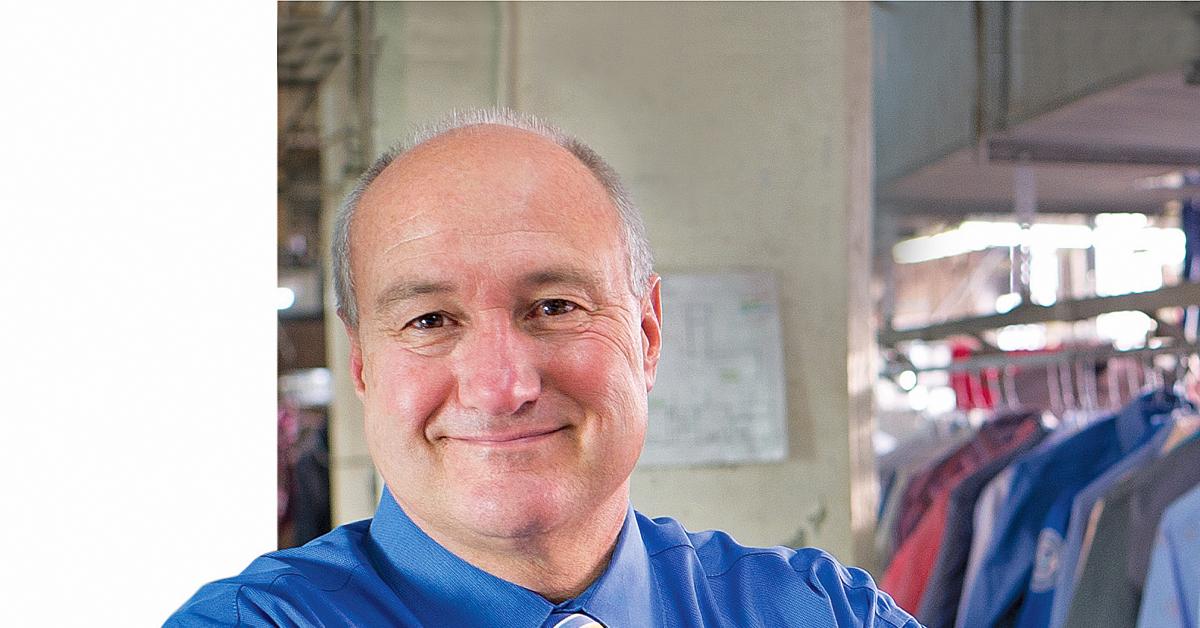FORT WAYNE, Ind. — Purchased in 2000 by Steve Grashoff and his wife, Laurie, Peerless Cleaners draws from multiple revenue streams, including commercial laundry, fire restoration, wedding gown preservation, household laundry, dry cleaning, laundered shirts, alterations, and Easy Cycle wash/dry/fold.
Making it simple, Peerless offers free pickup and delivery. “We don’t turn anything away,” says Steve. “In our small market being able to handle it all is crucial.” Similarly, so is cost control.
When first purchased, Peerless operated from a leased space while utilizing perc drycleaning machines and several used pieces of equipment. But in 2015 Grashoff moved the business into a new, 32,000-square-foot facility. That’s when Grashoff and Michael “Stucky” Szczotka, of Eagle Star Equipment, put their heads together.
Szczotka is an experienced dry cleaner owner/operator and provider of drycleaning and laundry equipment in Troy, Mich. He helped Grashoff outfit his new plant with eco-friendly equipment that set the stage for improved production, efficiency and quality.
That equipment mix includes two 90-pound capacity K4 alternative solvent drycleaning machines, a 60- and two 90-pound capacity Poseidon soft-mount wet cleaning machines, three 60-pound capacity Poseidon dryers, and a 20-inch Poseidon flatwork ironer with integrated folding system.
Peerless hasn’t been the same since. Business catapulted. The company gained new accounts, significantly grew commercial laundry services, became more effective in its fire restoration work, and effectively lowered utility and labor costs.
A MORE EFFECTIVE FIRE RESTORATION BUSINESS
Peerless has performed fire, flood and mold textile restoration as a franchise of Certified Restoration Drycleaning Network (CRDN) since 2003.
Prior to moving to the new building, Peerless successfully restored 90 percent of all incoming textiles impacted by fire and smoke. “Our restoration percentage was excellent,” says Grashoff, “but we still struggled with heavy-smoke items and the drycleaning process. I wanted to learn more about the best methods for removing heavysmoke so we could apply them at the new facility.”
After digging into best practices and talking with Szczotka, Steve Grashoff made wet cleaning his go-to restoration method.
“I found that wet cleaning is more effective and productive than dry cleaning when it comes to heavy-smoke restoration,” says Grashoff. “Dry cleaning involves extra steps to remove smoke odors that wet cleaning doesn’t.”
That’s why, since the move, textiles with heavy and medium smoke levels — even when dry-clean only — are processed through water using the plant’s Poseidon Textile Care System®.
In order to properly clean a huge variety of fabric types, the Poseidon wetcleaning machines are programmed with 45 unique wash programs. Each one delivers complete control over rotation action, fill levels, number of baths and rinses, water temperature, G-force extract speeds, and automatically injected chemical formulations. This makes it possible to restore textiles that could only be dry cleaned before, according to Grashoff.
“It’s amazing what we can wet clean,” Grashoff says. “We restore shoes, stuffed animals, clothing, drapes, pillows and even luggage. If needed, we can dial down rotation action to a gentle sloshing.”
After 30 to 45 minutes in the wash cycle, damp goods are transferred to a Poseidon dryer.
Offering phased programmability, the new technology dryers, like the wetcleaning machines, are programmed with 25 unique drying cycles to perfectly dry virtually anything — wool, synthetics, silk, taffeta, velvet. “We are adding programs daily,” he says.
Each dryer program offers a number of phases in which every variable of the drying process is precisely controlled, including drum rotation speed, drum rotation interval, moisture level, timed reversing, input air temperature, drying temperature, heating temperature, drying time and time limit. “There’s nothing like this dryer on the market today,” says Grashoff.
The dryers work by removing moisture very quickly, adds Szczotka. “They hit high drum temperatures extremely quickly in order to evaporate moisture without as much tumbling,” he says. Then, programmable moisture sensing ensures items dry to correct moisture levels, which prevents shrinkage and over-drying.
Most items come out of the dryers in 15 minutes with 10 percent residual moisture, according to Grashoff. “These cut drying time by 50 percent over the other dryers I have on the floor,” he says. “I have three Poseidon dryers and eight regular dryers,” says Grashoff. “With Poseidon, it’s like getting two dryers in one.”
Moreover, when compared with dry cleaning, the Poseidon system more effectively removes fire contaminants, according to Grashoff. “That’s good for us, the insurance company and the homeowner,” he says. “Thanks to our wetcleaning system, our heavy-smoke salvageable rate moved up from 50 to 90 percent.”
Check back Thursday for the conclusion.
Have a question or comment? E-mail our editor Dave Davis at [email protected].

